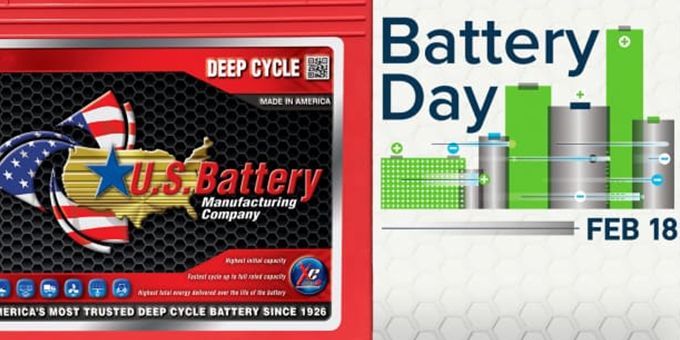Various business sectors and local and federal government agencies are increasingly looking to lead batteries as a vital energy resource. Lead-acid batteries are nearly 100-percent recycled in a closed-loop system and represent a sustainable resource.
 Battery Recycling Can Lead to a Better Future for Energy Resources
Battery Recycling Can Lead to a Better Future for Energy Resources

Article from | US Battery
Celebrating National Battery Day (February 18th) is a reminder to industries and consumers of the number of batteries we rely on daily, as well as our responsibility to recycle them properly. Various business sectors and local and federal government agencies are increasingly looking to lead batteries as a vital energy resource. Lead-acid batteries are nearly 100-percent recycled in a closed-loop system and represent a sustainable resource that is good for the environment.
Continuation of this closed-loop is an essential part of the manufacturing process. So in observance of NBD, people can contribute to a brighter future by gathering their old or used batteries and recycling them properly. Organizations like www.call2recycle.org, a national non-profit, are dedicated to helping consumers identify various battery types and locate local recycling centers and disposal options. This national effort is also designed to discourage the improper disposal of batteries in landfills, which can lead to chemical and fire hazards and potential injury to workers.
National And Local Economic Contributions
In addition to batteries being a sustainable and recyclable source of energy, they also provide more than 90-percent of the backup power required for localized 24/7 telecommunications backup recovery systems that protect lives, investments, and data in an emergency. Within the transportation and motive power sectors, 12V lead batteries have a projected growth reaching more than six percent in the automotive market alone between 2015 and 2030, bringing the market value to $31.9B.
In the United States, lead batteries have a $26.3-billion impact on economies that affect local suppliers, worker spending, transportation, and distribution networks. This impact provides an estimated $1.7-billion in annual payroll, supporting the battery industry that employs nearly 25,000 workers.
FUTURE IMPACT
As batteries increase in use and popularity, manufacturers look at ways to improve their efficiency. For example, flooded lead-acid (FLA)batteries are still widely used, despite their more than 150-year-old technology. To better power modern equipment, battery manufacturers continue to make product improvements, such as developing more efficient positive electrodes using tetrabasic lead sulfate crystals that create a highly uniform pattern. This pattern increases initial capacity, provides faster cycle-up to peak capacity, and enhances cycle life. Advances have also been made in maintenance-free Absorbed Glass Matt (AGM) batteries, including the prevention of positive electrode corrosion and the use of carbon-enhanced negative active materials. These have improved AGM battery’s charge acceptance in a partial state of charge applications and have helped to increase cycle life over previous models.
While Lithium-ion batteries are not new to mobile devices and computers, their use in electric vehicles, bicycles, and industrial applications continues to increase. New designs allow them to have an increased cycle-life from 2,000 to 5,000 cycles, and they can be discharged beyond 50-percent DOD without reducing cycle-life. The latest designs also feature an integrated battery management system (BMS), eliminating the need for additional electronics or special chargers in industrial applications.
Do Your Part
Gather old batteries and locate a local store, organization, or recycling facility to take them to. It’s also important to correctly identify the type of battery taken to a recycling center. Lithium-ion batteries cannot be recycled as lead-acid batteries are, and if they enter into the lead battery recycling facility, fires and explosions can occur. If you are unsure where or how to dispose of your used batteries, visit. www.call2recycle.org to find a local drop-off location. For more information on battery recycling processes, visit the Battery Council International at www.batterycouncil.org.
The content & opinions in this article are the author’s and do not necessarily represent the views of AltEnergyMag

US Battery
Since 1926, we have been designing and manufacturing the highest quality deep cycle batteries in the world. Starting out as a small manufacturing operation in San Diego, California and growing to the global company that you see today, having locations in Corona, California, Evans, Georgia and Augusta, Georgia, we work each day to supply our customers with the best batteries available. Through innovation and technology our products are the go-to energy storage batteries for a variety of applications including: scissor lifts, sweeper/scrubbers, golf carts, boats, RVs, renewable energy, and many other industries that require the constant energy delivered by quality deep-cycle batteries.
Other Articles
Selecting the Right Deep Cycle Battery
Lithium Batteries for Renewable Energy Applications
The Truth About Reviving Dead Batteries
More about US Battery
Comments (0)
This post does not have any comments. Be the first to leave a comment below.

